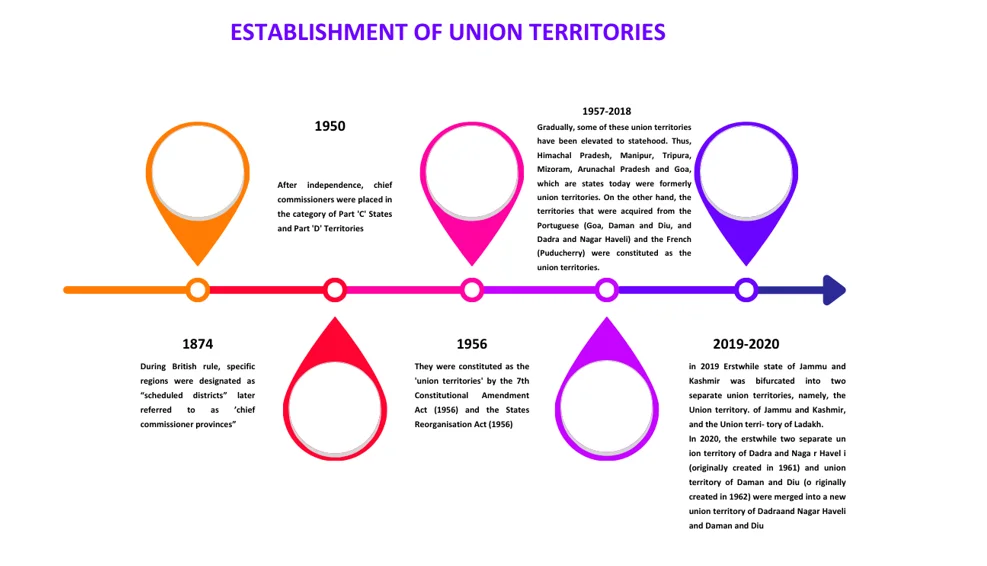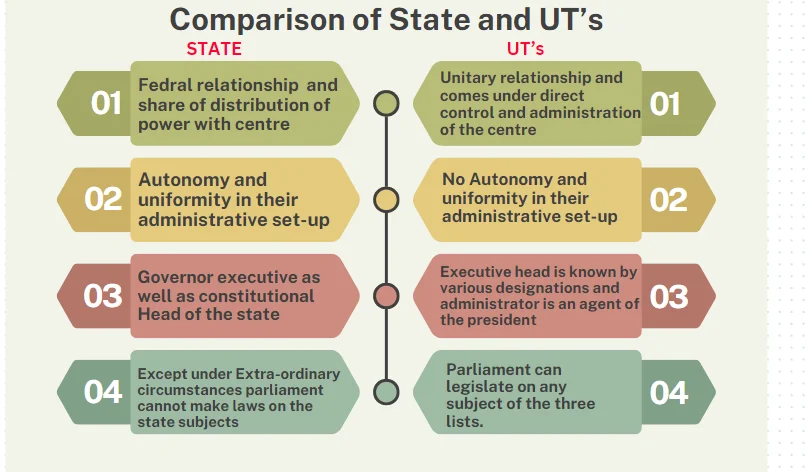India’s Union Territories, distinct from states, are directly managed by the central government. There are currently eight Union Territories, each with varying degrees of administrative autonomy. Their creation and governance address political, administrative, and cultural needs, reflecting the country’s diverse requirements.
Union Territories of India: Establishment, Governance, and Special Provisions
Territorial Classification of India: According to Article 1 of the Constitution, India is made up of three types of territories:
- The territories of the states,
- Union territories
- Territories that the Government of India might acquire in the future.
-
- Current Status: Currently, there are twenty-eight states, eight union territories, and no acquired territories.
- The states are part of the federal system in India and share power with the central government.
- On the other hand, union territories are areas directly controlled and managed by the central government. That’s why they are also called ‘centrally administered territories.’
- Central Administration and Legislative Powers: This arrangement is a significant departure from federalism in India because, in the case of Union Territories, the Parliament is empowered to legislate even on those subjects which fall under the State list of the Seventh Schedule of the Constitution.
Enroll now for UPSC Online Course
Establishment of Union Territories

-
Current Status: There are eight Union Territories in India. They are:
-
- Andaman and Nicobar Islands (created in 1956)
- Delhi (created in 1956)
- Lakshadweep (created in 1956)
- Puducherry (created in 1962)
- Chandigarh (created in 1966)
- Jammu and Kashmir (created in 2019)
- Ladakh (created in 2019)
- Dadra and Nagar Haveli and Daman and Diu (merged into one in 2020)
-
Changes in Names Of Union Territories
- Lakshadweep: Before 1973, Lakshadweep was known as Laccadive, Minicoy, and Amindivi Islands.
- National Capital Territory of Delhi: In 1992, Delhi was renamed as the National Capital Territory of Delhi, and
- Puducherry: until 2006, Puducherry was referred to as Pondicherry.
-
Reasons for Establishing Union Territories: These Union Territories were established for various reasons
-
- Political and Administrative Considerations: such as Delhi and Chandigarh.
- Preserving Cultural Distinctiveness: as seen in Puducherry and Dadra and Nagar Haveli and Daman and Diu.
- Recognizing their Strategic Importance: as in the case of Andaman and Nicobar Islands and Lakshadweep.
- Providing Special Attention To The Welfare Of Backward And Tribal Communities: which later became states, including Mizoram, Manipur, Tripura, and Arunachal Pradesh.
Jammu and Kashmir Reorganisation
Governance Structure
- Jammu and Kashmir Reorganisation (2019): In 2019, the state of Jammu and Kashmir was split into two new areas called Union territories. One is called the Union territory of Jammu and Kashmir, and the other is the Union territory of Ladakh.
- Reasons for Splitting Jammu and Kashmir into Union Territories: The government explained why they did this when they introduced the Jammu and Kashmir Reorganisation Bill in Parliament:
- Ladakh: is a large but sparsely populated area with difficult terrain. People in Ladakh had been asking for a long time to become a Union territory so they could have more control over their own future.
- Ladakh will not have its own legislature.
-
- Jammu and Kashmir: Due to security concerns, like terrorism from across the border, a separate Union territory was created for Jammu and Kashmir.
- Jammu and Kashmir will have its own legislature.
- Jammu and Kashmir: Due to security concerns, like terrorism from across the border, a separate Union territory was created for Jammu and Kashmir.
Merger of Dadra and Nagar Haveli, and Daman and Diu
In 2020, the government combined two Union territories, Dadra and Nagar Haveli, and Daman and Diu, into one area called Union Territory of Dadra and Nagar Haveli and Daman and Diu.
- Reason for merger: They did this because these places are similar in many ways.
- Shared History and Culture: They share the same administrative setup, history, language, and culture.
- Unified Government Departments: The people who run the government departments in these areas, like the police and forest officials, are the same.
- Similar Policies and Development Plans: Many policies and development plans, such as those for tourism, industries, education, and information technology, are alike.
- Issues with Duplication and Inefficiency: Having two different government entities in both areas was causing problems like duplication, inefficiency, and wasted money.
- Challenges in Government Management: It was also hard for the government to manage its employees and their careers.
Governance of Union Territories
Administrative Provisions: Provisions with respect to the administration of The Union Territories are described under Part VIII of the Constitution from Article 239 to 242.

- Even though all union territories fall into the same category, their administrative systems are not the same.
- Presidential Management: Each union territory is managed by the President through an administrator appointed by them.
- Unlike a governor who is the head of state, an administrator is an agent of the President.
- Titles of Administrators Determined by the President: The President can decide the title of an administrator, such as Lieutenant Governor, Chief Commissioner, or Administrator.
- Lieutenant Governor: for Delhi, Puducherry, Andaman and Nicobar Islands, Jammu and Kashmir, and Ladakh.
- Administrators: For Chandigarh, Dadra and Nagar Haveli, Daman and Diu, and Lakshadweep.
- Legislative Assemblies and Parliamentary Control:
- Puducherry got its legislative assembly in 1963, Delhi in 1992, and Jammu and Kashmir in 2019. They have a Council of Ministers led by a Chief Minister.
- The other six union territories don’t have these political setups.
- However, even if these institutions are established, the President and Parliament still have the highest control over them.
- Parliamentary Authority: The Parliament can make laws on any topic for the union territories, including those in the State List.
- This power extends to Puducherry, Delhi, and Jammu and Kashmir, despite them having their own legislatures.

- Legislative Powers of Union Territories with Assemblies: However, the legislative assembly of Puducherry can make laws on State List and Concurrent List subjects.
- Delhi’s Legislative Assembly: can make laws on State List topics (except public order, police, and land) and Concurrent List.
- Legislative assembly of Jammu and Kashmir: can make laws on State List matters (except public order and police) and Concurrent List.
- Presidential Rule-Making Authority in Union Territories: The President has the authority to create rules for the peace, progress, and good governance of certain areas like the Andaman and Nicobar Islands, Lakshadweep, Dadra and Nagar Haveli, Daman and Diu, and Ladakh.
- In Puducherry, the President can make rules only when the assembly is not functioning.
- These rules have the same power as laws passed by Parliament and can even replace or change any law passed by Parliament for these places.
The Parliament can set up a High Court for a territory or assign it to the High Court of a nearby state.
- Delhi is the only Union territory with its own high court since 1966.
- The Bombay High Court covers Dadra and Nagar Haveli, Daman and Diu,
- Andaman and Nicobar Islands comes under jurisdiction of Calcutta High court
- Chandigarh come under the jurisdiction of Punjab and Haryana High Court
- Lakshadweep come under the jurisdiction Kerala High Court
- Puducherry come under the jurisdiction Madras High Court
- Jammu and Kashmir and Ladakh share a common high court Jammu and Kashmir & Ladakh High Court


Delhi: Case Sui Generis (Article 239AA and 239AB)
- 69th Constitutional Amendment Act: In 1991, the 69th Constitutional Amendment Act gave a unique status to Delhi. It was renamed the National Capital Territory of Delhi, and the administrator became the Lieutenant Governor.
- This amendment introduced a legislative assembly and a Council of Ministers headed by the Chief Minister for Delhi.
- The assembly, with 70 members directly elected by the people through elections conducted by the Election Commission of India, can make laws on most matters except public order, police, and land, which are controlled by the Parliament.

- Council of Ministers Allocation: Ten percent of the assembly’s total strength is allotted to the council of ministers, which is composed of the Chief Minister and six additional ministers.
- Role of the Council of Ministers: The group of ministers, led by the Chief Minister, provides advice to the Lieutenant Governor in carrying out their duties, except when the Lieutenant Governor needs to make decisions independently.
- Presidential Intervention: If there’s a disagreement between the Lieutenant Governor and the ministers, the matter is referred to the President for a decision and acts accordingly.
- In situations where the territory’s administration can’t be carried out according to the above provisions, the President can suspend them and make necessary provisions to run the territory.

- Presidential Control: In simple terms, if the constitutional machinery fails, the President can take control of the territory.
- This can happen based on the Lieutenant Governor’s report or other reasons, similar to Article 356, which deals with the President’s Rule in states.
- Power to issue Ordinance: The Lieutenant Governor has the authority to issue ordinances when the assembly is not in session.
- An ordinance has the same power as a law passed by the assembly.
- However, it must be approved by the assembly within six weeks of its reconvening.
Enroll now for UPSC Online Course
-
- The Lieutenant Governor can also revoke an ordinance at any time, but they cannot issue one when the assembly is dissolved or suspended.
| Must Read | |
| Current Affairs | Editorial Analysis |
| Upsc Notes | Upsc Blogs |
| NCERT Notes | Free Main Answer Writing |
Conclusion
Union Territories play a unique role in India’s federal structure, balancing central control with local governance. Despite their administrative differences, these territories contribute to the country’s overall cohesion and efficient management.
- Their evolving status and governance highlight India’s commitment to addressing regional and strategic concerns.
Sign up for the PWOnlyIAS Online Course by Physics Wallah and start your journey to IAS success today!
| Related Articles | |
| Federalism | Major Constitutional Amendments: Evolution of India’s Constitution |
| Union Territories | Constitution: A Living Document |

 GS Foundation
GS Foundation Optional Course
Optional Course Combo Courses
Combo Courses Degree Program
Degree Program









